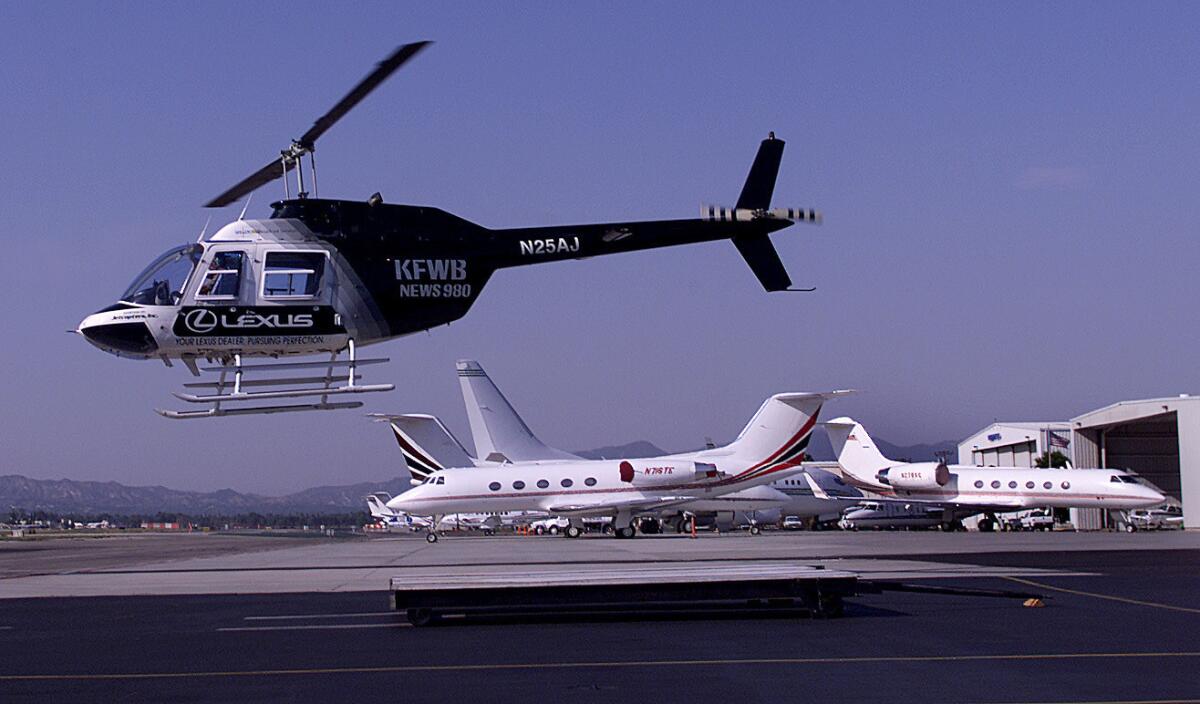Congress OKs measure to cut helicopter noise in L.A. County

- Share via
After an earlier effort by local lawmakers failed to fly, legislation designed to reduce helicopter noise and improve safety in the skies above Los Angeles County was finally approved by Congress on Thursday.
A day after the House of Representatives passed the measure, the Senate voted in favor of the Los Angeles Residential Helicopter Noise Relief Act, sending the bill to the president’s desk for his signature.
The measure was tacked on to the omnibus budget bill, which also was approved and included $65 million each for the subway extension to Los Angeles’ Westside and construction of a regional connector for all the county’s light-rail lines.
“This legislation will hold the Federal Aviation Administration’s feet to the fire and ensure that they are making every effort to reduce helicopter noise,” said Rep. Adam Schiff (D-Burbank), who pushed for the noise relief act after the bill introduced in 2011 by former Rep. Howard Berman (D-Valley Village) stalled.
The measure requires the FAA to evaluate and revise existing helicopter routes to reduce noise impacts on residential areas and landmarks, such as the Hollywood Bowl, the Hollywood sign and celebrities’ homes.
The agency must study whether helicopters can fly safely at higher altitudes and promote the best ways to reduce noise while hovering and covering news events.
FAA officials also are required to develop a complaint system for the public and inform helicopter pilots about any voluntary guidelines and noise sensitive areas of the county.
If the goals are not met with a voluntary approach one year after the bill is enacted, the FAA must develop regulations.
The law, however, does not apply to flights by the military and public safety agencies.
The measure stems from years of complaints by residents of neighborhoods across Los Angeles County that have been buzzed by low-flying helicopters.
In August 2012 and June last year, hundreds of people turned out at two public hearings hosted by local elected officials. One after another they testified about the window rattling din of rotor blades that made it difficult to sleep, talk on the telephone or have a normal conversation.
People from neighborhoods that have landmarks or celebrity residents told lawmakers that they were under constant assault by choppers carrying sightseers, paparazzi and even real estate agents.
FAA officials declined to comment on the noise relief act, saying they do not publicly discuss federal legislation that affects the agency as a matter of policy.
The FAA has been working with neighborhood groups, noise coalitions and helicopter pilots to come up with voluntary measures to reduce the number of annoying flights. A status report on the effort is due out soon.
“Most of what they are talking about in the measure is already being done,” said Larry Welk, the owner of a helicopter company and president of the Professional Helicopter Pilots Assn. “Homeowner associations, noise coalitions and others involved say progress is being made.”
Helicopter pilots and their associations have questioned the need for government regulation, saying the Fly Friendly program and other voluntary efforts to inform pilots about noise sensitive areas and how to avoid them have been fruitful.
Welk said most of the noise problems actually involve helicopters operated by the military, police, fire departments and medivac operations, all of which are exempt from the law. He estimated that those operators account for 70% of all flights in Los Angeles County.
John Bailey of Torrance, a member of the Los Angeles Area Helicopter Noise Coalition, disagreed with Welk, saying the legislation is needed to spur the voluntary effort that is underway.
Bailey said community groups in Torrance have seen few results after working with city officials and helicopter interests, including the Robinson Helicopter Co., for at least four years to reduce noise in residential areas.
Based at Torrance Municipal Airport, Robinson is the world’s largest manufacturer of helicopters for the civilian market and conducts numerous flights over the South Bay.
“We have not seen a commitment from the helicopter operators,” Bailey said. “We’ve not gotten any relief.”
[email protected]
[email protected]
twitter: @LADeadline16
More to Read
Sign up for Essential California
The most important California stories and recommendations in your inbox every morning.
You may occasionally receive promotional content from the Los Angeles Times.












